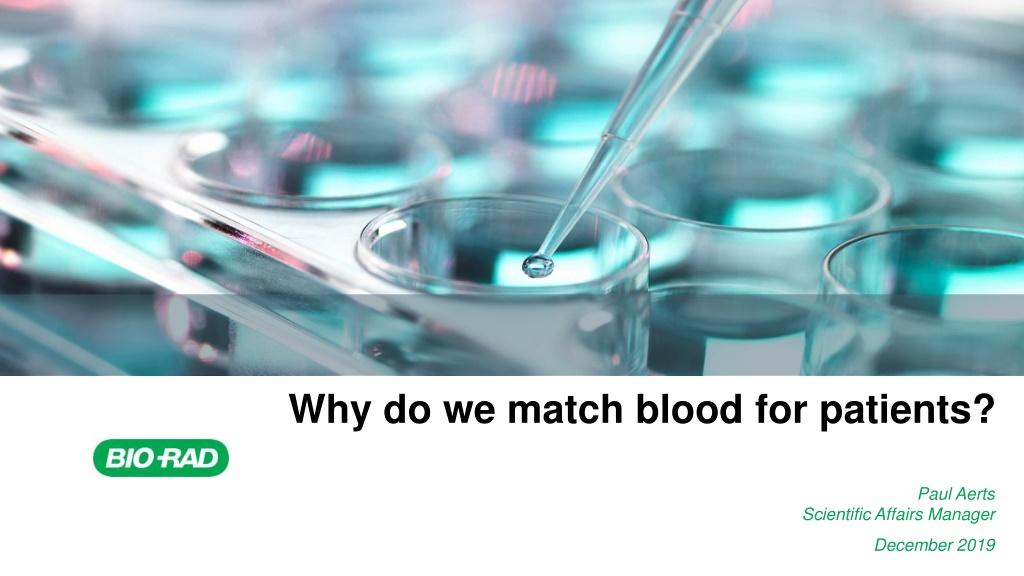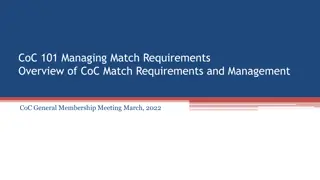Why Do We Match Blood for Patients?
Blood matching for patients is crucial to prevent adverse reactions like hemolysis and death. ABO and RhD compatibility testing are fundamental, along with selecting antigen-negative units for patients with clinically significant antibodies. Beyond mandatory requirements, matching can be complex due to the diversity of blood antigens, emphasizing the necessity of careful selection to ensure patient safety.
Download Presentation

Please find below an Image/Link to download the presentation.
The content on the website is provided AS IS for your information and personal use only. It may not be sold, licensed, or shared on other websites without obtaining consent from the author. Download presentation by click this link. If you encounter any issues during the download, it is possible that the publisher has removed the file from their server.
E N D
Presentation Transcript
Why do we match blood for patients? Paul Aerts Scientific Affairs Manager 1 December 2019
Why do we match blood for patients? ABO mandatory RhD mandatory Mandatory when alloantibodies are present Beyond what is mandatory prevention of immunisation less cost less delay less errors (chances of ...) Antibodies to high incidence antigens Anti-Vel, -U, -FY3, But matching causes delay Transfusing high spec units when they are not required makes them unavailable when required! 2
ABO: mandatory ABO antigens are present on Red blood cells Platelets Many circulating proteins Many tissues (endothelium, kidney, heart, bowel, pancreas, lung) Transfusion of ABO-incompatible usually is associated with Intravascular hemolysis Renal failure Death ABO blood grouping and ABO compatibilty testing are the foundation of all pretransfusion testing 3
D: mandatory Most important antigen in the Rh blood group system Highly immunogenic > 1/3 of D neg produce anti-D after a transfusion with D pos blood D pos red cells are usually not tranfused to D neg patients D pos blood should never be given to D neg girls D neg women of child-bearing age Anti-D causes HTR HDFN D pos blood can be given to Female patients > 50 yrs (UK), provide they have no (history) of anti-D Adult males: D neg or D status unknown Patients undergoing large volume transfusions (> 8 units) EXCLUDING children, females < 50 yrs, and patients with alloanti-D 4
Patients with alloantibodies Patients with clinically significant antibodies Antigen negative units should be selected and IAT crossmatched Also when the antibody - previously identified is no longer detectable in the current sample! Most countries will additionally match in these cases For RhCE For K (or routinely would give K-) to prevent further immunisation 5
Beyond what is mandatory Matching for ...? Matching is not (always) easy (38 systems, close to 400 antigens) Patient is DCCee K- M-S- Jk(a-) Fy(a-) Patient is DccEE K- s- Jk(b-) Fy(b-) 20% 18% 2.7% 0.62% 0.2% 2% 1.8% 0.18% 0.042% 0.014% 90% 90% 10% 15% 25% 23% 17% 34% 1 in 500! 1 in 7143! 6
High Risk Groups Sickle Cell Disease most frequent genetic disease in France, for instance 15000 known, expected to double over 15 yrs Most guidelines match for Rh and K (as a minimum) Black Rh phenotype Dccee (R0r) Up to 47% of them alloimmunize! Establish full phenotype genotype (RH, FY, JK, MNS, ) Match within ethnic group, which is problematic because donor base is predominantly local High rate of RH variants (lacking high incidence antigens) and Fy(a-b-), and U- Others MDS: 58% immunisation rate Thalassemia: 37% immunisation rate Therapeutic monoclonals (a-CD38, anti-CD47) 8
High risk groups Pregnancy Of course ABO/D mandatory Immunisation rate comparable to the average (1 to 4%) Slightly higher for c (RH4) Relatively high for K (KEL1) mostly from transfusion Guidelines not identical throughout Europe Most say: K- Some say: Rh match (D and CE) NL specific on c and E 9
Summary Matching reduces risks of HTR due to undetectable antibodies (patient history national databank) Matching prevents alloimmunization Benefit for high risk groups Matching may delay transfusion Population in some countries becoming more diverse Donor populations do not always match patient population 10

































